Picture this: you’re unwinding in your hot tub after a grueling day, feeling the stress melt away with each bubbling jet.
Suddenly, you hear the familiar click-clack of paws on the deck, and there’s your furry best friend, giving you those irresistible puppy eyes, practically begging to join you in your watery oasis.
It’s a heartwarming scene, right? But hold your horses – or in this case, your hounds! Before you invite your canine companion into the steamy waters, let’s dive deep into the crucial question: can a dog really go in a hot tub?
Can a Dog Go In a Hot Tub?
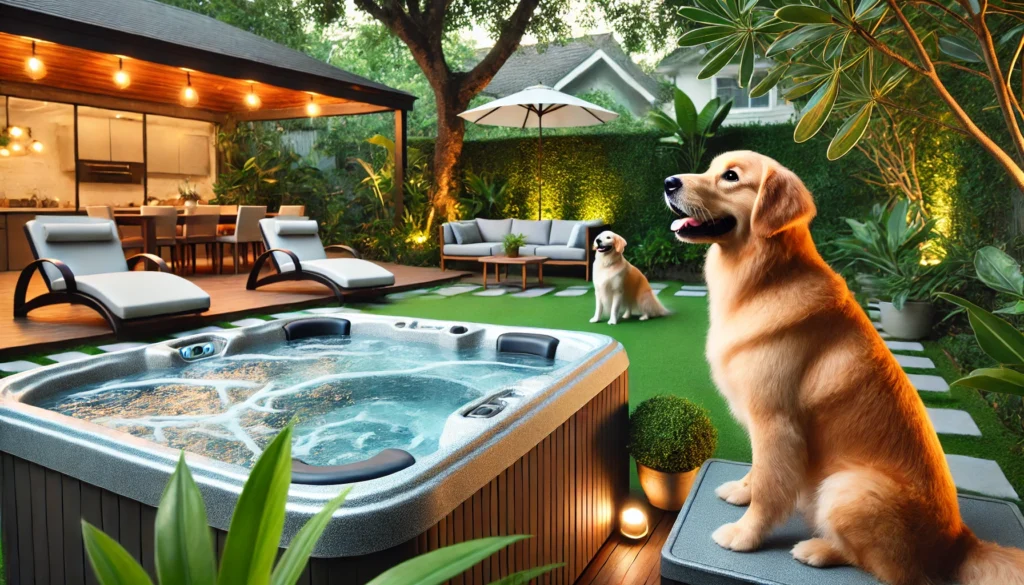
No, it’s generally not safe for dogs to go in hot tubs. As a long-time dog owner and hot tub enthusiast, I’ve learned this lesson the hard way, and I’m here to share my experiences so you don’t have to make the same mistakes I did.
Hot tubs are designed with human comfort and relaxation in mind, but they can pose serious risks to our four-legged friends. The combination of high water temperatures, potent chemicals, and the physical design of hot tubs creates an environment that’s simply not suitable for dogs.
This seemingly innocent indulgence can lead to a host of health issues for your pup, ranging from overheating and chemical irritation to more severe problems like drowning.
I know it might seem like a fun idea to share a relaxing soak with your furry companion, but trust me, it’s best to find safer alternatives to keep them cool and happy. Don’t worry, though – we’ll explore plenty of great options later in this article.
For now, let’s dive deeper into why hot tubs and dogs don’t mix, and what you can do to ensure your pup stays safe while you enjoy your spa time.
The Risks of Dogs in Hot Tubs
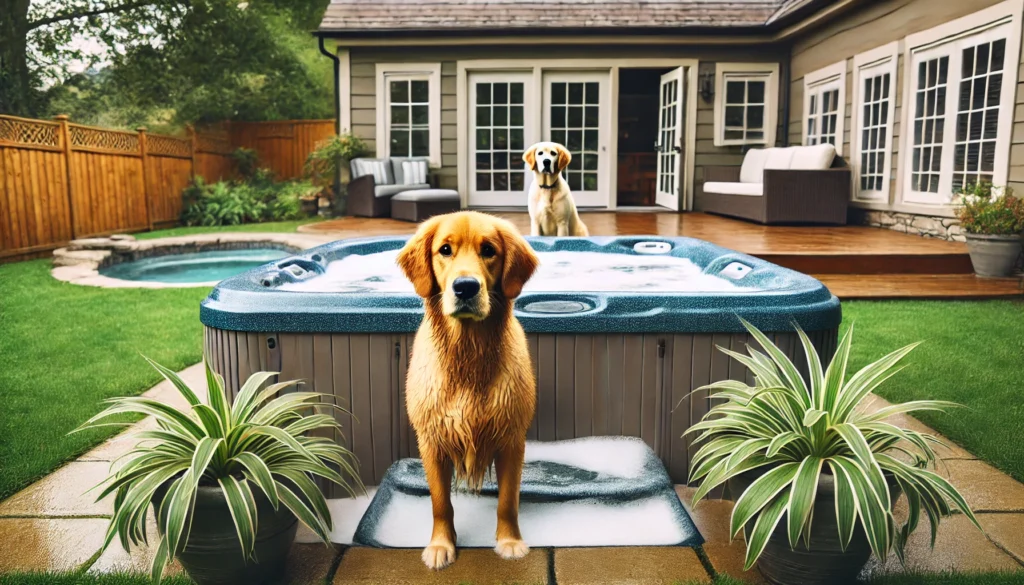
Alright, gather ’round, fellow dog lovers, because I’m about to spill the tea – or should I say, the hot tub water – on why these bubbly oases are a no-go for our furry friends. When I first got my hot tub, I thought it’d be the ultimate bonding experience to have my golden retriever, Max, join me for a dip.
Boy, was I in for a rude awakening! Here’s the lowdown on why hot tubs and dogs are like oil and water – they just don’t mix:
- High temperatures and overheating: This is the biggie, folks. Dogs can’t sweat like we do, which makes them prone to overheating faster than you can say “fetch.”
I’ll never forget how Max started panting heavily after just a few minutes in the hot water. His tongue was hanging out like it was trying to escape his mouth, and I swear I could almost see steam coming off his fur.
It scared the living daylights out of me!
The normal body temperature for dogs is around 101-102.5°F (38.3-39.2°C), and most hot tubs are set between 100-104°F (37.8-40°C). You can see how quickly things can go south, right?
Even a short dip can raise their body temperature to dangerous levels, potentially leading to heat stroke. And let me tell you, a trip to the emergency vet at 2 AM is not how you want to end your relaxing hot tub session.
- Chemical exposure: All those chemicals we use to keep our hot tubs clean and sparkling? They’re about as dog-friendly as chocolate-covered onions.
The chlorine, bromine, and other sanitizers can irritate your dog’s skin, eyes, and respiratory system. Max’s beautiful golden coat got all dry and itchy after our little “spa day,” and he was scratching like he was trying to dig his way to China.
Trust me, it’s not worth the hassle or the vet bills.
But it’s not just about the itching. These chemicals can be harmful if ingested, which is a real risk considering how much dogs love to lick themselves (and everything else).
Plus, the steam from the hot water can carry these chemicals into their lungs, potentially causing respiratory issues. Not exactly the relaxing experience we were going for, huh?
- Drowning hazards: Now, I know what you’re thinking – “But my dog is a great swimmer!” Well, let me tell you, hot tubs are a whole different ball game.
They’re deeper than you might think, and dogs can easily get tired or disoriented, especially with all those jets bubbling away.
I’ve heard horror stories from other dog owners about close calls. One friend’s Jack Russell got sucked against a filter and panicked, and another’s Labrador couldn’t figure out how to get out of the tub because of the high sides.
It’s just not worth the risk, folks. Plus, if your dog isn’t a strong swimmer to begin with, the dangers are even greater.
- Bacterial infections: Even with all those chemicals we just talked about, hot tubs can be breeding grounds for bacteria. The warm, moist environment is like a five-star hotel for these microscopic troublemakers.
Dogs are more susceptible to ear infections and skin problems when exposed to this environment.
Been there, done that – and let me tell you, cleaning infected dog ears is no picnic! Max ended up with a nasty ear infection after our hot tub adventure, and the smell… well, let’s just say it wasn’t exactly eau de parfum.
It took weeks of medication and cleaning to clear it up, and he was miserable the whole time.
- Slips and falls: Hot tub surroundings are usually wet and slippery, which can be a recipe for disaster for our four-legged friends. Dogs, especially excited ones, might slip and hurt themselves trying to get in or out of the tub.
I once saw Max do an unintentional slip-and-slide across my deck after shaking off near the hot tub. Thankfully, he was fine, but it could have ended much worse.
- Dehydration: It might sound counterintuitive, but sitting in water can actually lead to dehydration. The hot temperature makes dogs pant more, losing water through their mouth and paw pads.
And unlike us, they can’t exactly reach for a cold drink while soaking.
So, there you have it – the not-so-hot truth about dogs and hot tubs. It’s a combo that looks fun on paper but can lead to a world of trouble in reality.
But don’t worry, we’re not here to be all doom and gloom. Keep reading, and I’ll share some great alternatives to keep your pup cool and happy without turning your hot tub into a dog soup!
Why Hot Tubs Can Be Dangerous for Dogs
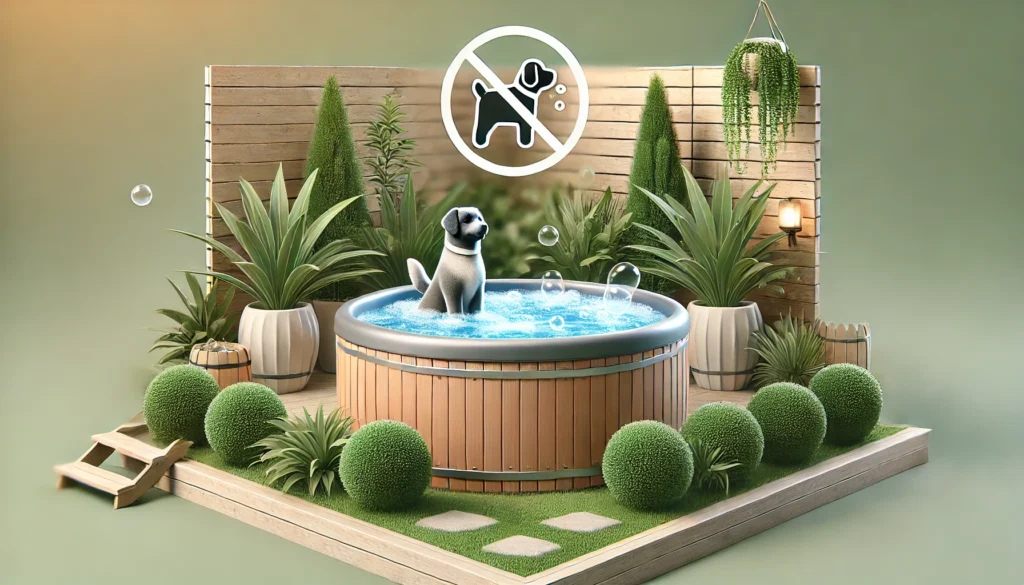
Alright, let’s get into the nitty-gritty of why hot tubs are a no-go for our furry friends. It’s not just about them getting wet – there’s some serious science behind it!
First off, dogs and humans have very different ways of regulating body temperature. We’ve got sweat glands all over our bodies, but dogs?
They’re mostly limited to panting and sweating through their paw pads. So when Max jumped into my hot tub that one time, his body couldn’t cool down efficiently.
It was like watching a furry kettle about to boil over!
Here’s a quick biology lesson: dogs primarily cool themselves by panting, which allows for evaporative cooling as air passes through their mouth and over their tongue. They also have some sweat glands in their paw pads, but these aren’t nearly as effective as our full-body sweat system.
In a hot tub, the humid environment makes panting less effective, and their paw pads are submerged, eliminating that cooling method entirely.
To make matters worse, some dog breeds are even more susceptible to overheating. Brachycephalic breeds (those with short snouts like Bulldogs, Pugs, and Boston Terriers) have a harder time panting effectively and are at higher risk in hot environments.
Long-haired breeds can also overheat more quickly. So if you’ve got a Husky or a Bulldog, the hot tub is definitely off-limits!
And don’t even get me started on the chemicals. You know how your eyes can get all red and irritated after a long soak?
Well, imagine that, but all over your body, and you can’t tell anyone about it. That’s what our poor pups go through when exposed to hot tub chemicals.
Max’s skin was dry and itchy for days afterward. I felt terrible!
The thing is, a dog’s skin is more sensitive than ours. It has a different pH balance and is more permeable, meaning it absorbs chemicals more easily.
The chlorine or bromine in your hot tub can strip the natural oils from your dog’s coat, leading to dry, itchy skin. In some cases, it can even cause chemical burns.
And if they accidentally ingest the water (which let’s face it, is pretty likely with dogs), it can lead to stomach upset or more serious issues.
The physical challenges are no joke either. Hot tubs are designed for humans to sit and relax, not for dogs to swim or stand in.
The jets can be disorienting, and the slippery surfaces are an accident waiting to happen. I once saw Max try to get out of the tub on his own – it was like watching a cartoon character running in place!
Most hot tubs are designed with seats and footwells, which can create underwater obstacles for dogs. They might struggle to keep their head above water or get trapped in a corner.
The strong jets can push them around or even hold them underwater if they’re not strong enough to swim against the current.
And let’s talk about those filters and drains. They might not seem like a big deal to us, but for a dog, they can be downright dangerous.
The suction from these systems can trap a dog underwater or even cause internal injuries if they get too close. It’s not a risk worth taking, no matter how well you think you know your hot tub.
Temperature is another crucial factor. While we might find 104°F (40°C) relaxing, it’s dangerously hot for dogs.
Their normal body temperature is already higher than ours, so they have less tolerance for additional heat. Prolonged exposure to these high temperatures can lead to heat stroke, which can be fatal if not treated quickly.
Signs of heat stroke in dogs include:
- Excessive panting
- Drooling
- Reddened gums
- Vomiting
- Diarrhea
- Mental dullness or loss of consciousness
- Uncoordinated movement
- Collapse
If you ever suspect your dog is experiencing heat stroke, it’s crucial to cool them down gradually and get them to a vet immediately. This is a life-threatening emergency!
So, while it might be tempting to let your furry friend join you for a soak, the risks far outweigh any potential benefits. Hot tubs are simply not designed with dogs in mind, and the combination of heat, chemicals, and physical design creates a potentially dangerous environment for our canine companions.
Safe Alternatives for Dogs

After my hot tub fiasco with Max, I knew I had to find some better ways to keep him cool and happy during those scorching summer days. Here are some pawsome alternatives that have worked wonders for us:
- Doggy pools and splash pads: I bought Max his own kiddie pool, and let me tell you, it’s been a game-changer! He loves splashing around in the shallow water, and I don’t have to worry about him overheating or drowning.
Plus, watching him do his best “doggy paddle” in six inches of water is hilarious!
For a step up from the basic kiddie pool, consider a dog-specific splash pad. These usually have sprinklers or fountains that your pup can run through.
It’s like a water park for dogs! Just remember to supervise your furry friend and change the water regularly to keep it clean.
- Cooling mats and vests: On really hot days, I break out Max’s cooling vest. It’s like a little air conditioner he wears!
You soak it in cold water, wring it out, and put it on your dog. As the water evaporates, it keeps them cool.
He looks pretty dapper in it too, if I do say so myself.
The cooling mat is great for when he’s just lounging around – it’s like his own personal chill-out zone. These mats usually contain a gel that stays cooler than room temperature.
Max loves to sprawl out on his after a game of fetch.
- Supervised shallow water play: We’ve had some great times playing with the sprinkler or a gentle hose spray. Max goes absolutely bonkers chasing the water stream!
It’s a fantastic way for him to cool off and get some exercise without any of the risks of a hot tub.
You can even set up a doggy obstacle course with the sprinkler for some added fun. Just be mindful of water usage, especially if you live in an area with water restrictions.
- Frozen treats and toys: Who doesn’t love a popsicle on a hot day? For dogs, frozen treats can be a great way to cool down.
I freeze some low-sodium chicken broth in ice cube trays for Max. He loves crunching on these icy treats!
You can also stuff a Kong toy with a mixture of yogurt and mashed banana, then freeze it. It keeps Max busy for ages and helps him stay cool.
- Indoor activities: Sometimes, the best way to beat the heat is to stay inside. On really hot days, we play indoor games like hide-and-seek or practice new tricks.
It keeps Max mentally stimulated without overheating.
- Early morning or late evening walks: During the hottest parts of the year, we adjust our walking schedule. Early morning or late evening walks help us avoid the worst of the heat while still getting plenty of exercise.
- Elevated beds with air flow: For outdoor lounging, an elevated dog bed can be a great option. These beds allow air to circulate underneath, keeping your pup cooler than if they were lying on the hot ground.
Remember, the key is to always supervise your dog around water, even if it’s shallow. I learned that lesson the hard way when Max decided to try and “dig” his way to China through his kiddie pool.
Let’s just say my backyard looked like a muddy war zone for a week!
Also, always make sure your dog has access to plenty of fresh, cool water to drink. Hydration is key in hot weather, whether they’re playing in water or not.
By providing these safer alternatives, you can ensure your dog stays cool and happy during the hot months without the risks associated with hot tub use. Plus, many of these options allow you to join in the fun, creating great bonding experiences with your furry friend.
Who needs a hot tub when you can have a splash party with your best pal?
How to Keep Your Dog Safe Around Hot Tubs
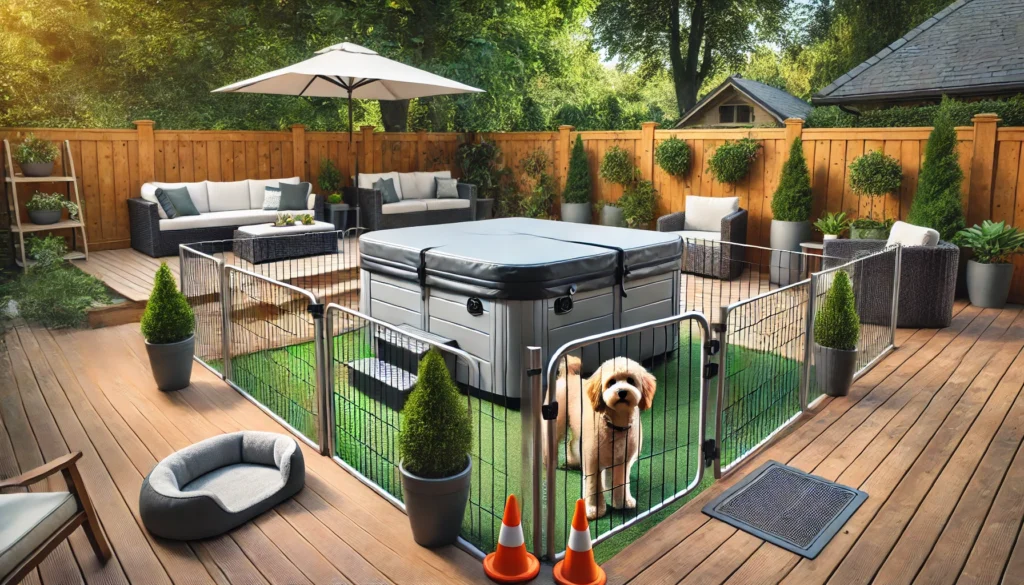
Now, I know some of you might be thinking, “But I love my hot tub AND my dog! How can I have both?” Don’t worry, I’ve got you covered.
Here are some tips to keep your furry friend safe while you enjoy your soak:
- Secure hot tub covers: Invest in a sturdy, lockable cover. Trust me, it’s worth every penny.
I once caught Max trying to use my old, flimsy cover as a trampoline. Talk about a heart attack!
A good cover not only keeps your dog out when you’re not using the tub, but it also prevents accidents if they sneak out into the yard unsupervised.
Look for covers that are strong enough to support your dog’s weight and have locks that a clever pup can’t figure out. Some covers even come with alarms that will alert you if they’re tampered with.
- Creating barriers: Consider fencing off your hot tub area. It might seem like overkill, but it’s better than constantly worrying about your pup taking an unsupervised dip.
Plus, it gives you a nice, private spa area. Win-win!
If a full fence isn’t feasible, you could use deck gates or even portable pet gates to create a barrier. Just make sure it’s tall enough that your dog can’t jump over it.
For smaller dogs, even a low decorative fence might be enough to designate the area as off-limits.
- Teaching commands: This one’s been a lifesaver for me and Max. I taught him the “leave it” command, and now he knows the hot tub is off-limits.
Of course, he still gives me those puppy dog eyes every now and then, but at least he stays safe.
Start by teaching the command with less tempting objects, then gradually work your way up to the hot tub. Use lots of positive reinforcement – treats, praise, and play – when your dog successfully ignores the tub on command.
- Provide alternative relaxation spots: Set up a comfy dog bed or cooling mat near (but not too near) the hot tub area. This gives your dog a designated spot to relax while you’re enjoying your soak.
Max loves his little “chill zone” where he can keep an eye on me without getting too close to the water.
- Never leave your dog unsupervised: This is crucial. Even with all other precautions in place, never leave your dog alone around the hot tub.
Accidents can happen in the blink of an eye.
- Keep chemicals out of reach: Store your hot tub chemicals in a locked cabinet or high shelf where your curious canine can’t get to them. I learned this lesson when I found Max trying to play with a chlorine tablet like it was a frisbee.
Not exactly the game of fetch I had in mind!
- Rinse off your dog after hot tub time: If you’ve been in the hot tub, make sure to rinse off before petting your dog. The chemicals on your skin could transfer to their fur and cause irritation.
I always keep a towel handy to dry off before giving Max his welcome-back pets.
- Use visual deterrents: Some dogs respond well to visual cues. You could try placing brightly colored cones or signs around the hot tub area.
It might look a bit like a construction zone, but hey, whatever keeps your furry friend safe, right?
- Consider a pet-safe hot tub alarm: These nifty devices can alert you if your dog gets too close to the hot tub. They’re especially useful for those midnight bathroom breaks when you’re not around to supervise.
- Regular maintenance checks: Make sure your hot tub is in good condition with no loose parts or exposed wiring that could harm your curious pup. I do a quick check every week, just to be on the safe side.
Remember, consistency is key when training your dog to stay away from the hot tub. And hey, a few treats never hurt in the training process.
Just don’t drop them in the water – fishing out soggy dog biscuits is not how I like to spend my relaxation time!
What to Do If Your Dog Accidentally Gets in the Hot Tub
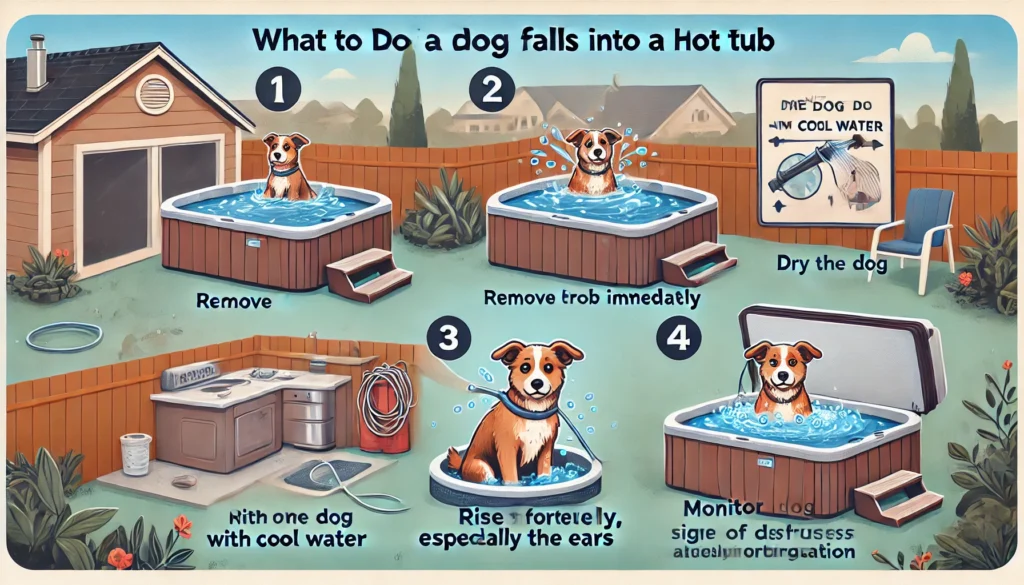
Okay, let’s talk worst-case scenario. Accidents happen, right?
If your furry friend takes an unexpected plunge, here’s what you need to do:
- Immediate actions:
- Get them out of the hot tub ASAP! Every second counts when it comes to preventing overheating or drowning.
- Rinse them off with cool (not cold) water to remove chemicals and help lower their body temperature. I keep a hose nearby for just such emergencies.
- Dry them thoroughly, paying special attention to their ears. Water in the ears can lead to painful infections.
- If it’s a hot day, you might want to bring them into an air-conditioned space to help them cool down faster.
- Signs of distress to watch for:
- Excessive panting or drooling: This could be a sign of heat stress or chemical irritation.
- Vomiting or diarrhea: These symptoms might indicate that your dog ingested some of the hot tub water.
- Lethargy or disorientation: This could be a sign of overheating or a reaction to chemicals.
- Redness or irritation on the skin: Check their whole body, including paw pads and the insides of their ears.
- Coughing or difficulty breathing: This could indicate water inhalation or chemical irritation of the airways.
- Changes in gum color: Pale or blue-tinged gums can be a sign of serious distress.
- When to contact a veterinarian:
- If you notice any of the above signs of distress
- If your dog ingested a lot of hot tub water
- If you’re unsure about their condition – better safe than sorry!
- If your dog has any pre-existing health conditions that might be exacerbated by the incident
- Follow-up care:
- Monitor your dog closely for the next 24-48 hours, even if they seem fine initially.
- Watch for any delayed symptoms like lethargy, loss of appetite, or changes in bathroom habits.
- If your dog has long or thick fur, consider giving them a proper bath to ensure all chemicals are removed from their coat.
I’ll never forget the time Max managed to sneak into the hot tub while I was refilling my drink. Talk about a panic moment!
But thanks to quick action (and a very patient vet), he was fine. Now I always keep a close eye on him around the tub, even with all our safety measures in place.
The Importance of Prevention and Awareness
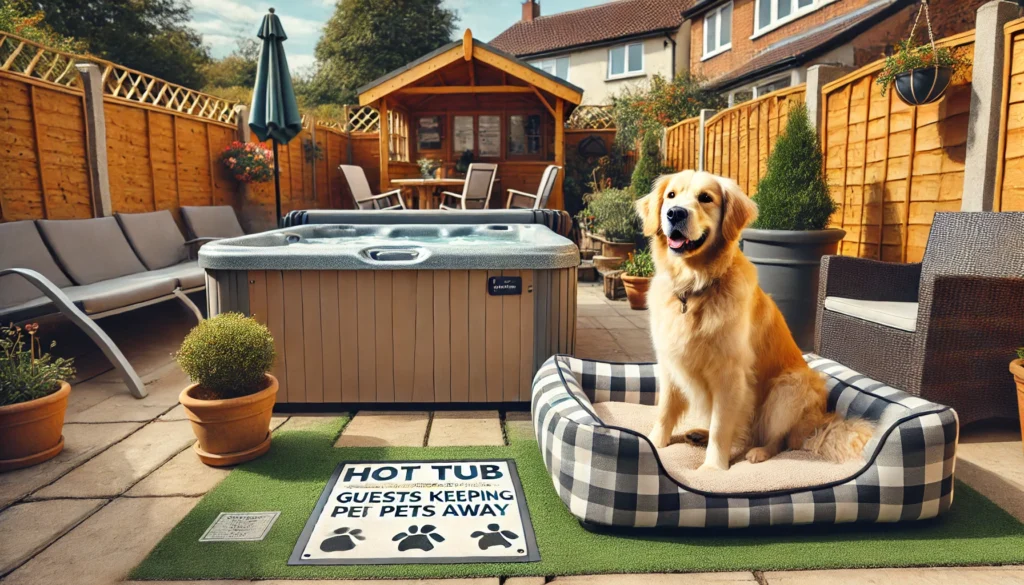
After all we’ve discussed, I can’t stress enough how important it is to be proactive about hot tub safety when you have pets. It’s not just about avoiding a scare or a vet bill – it’s about protecting a beloved member of your family.
Creating a pet-safe environment around your hot tub isn’t just good for your dog; it can give you peace of mind too. Imagine being able to relax in your hot tub without constantly worrying about your furry friend getting into trouble.
That’s the kind of stress-free soaking we’re aiming for!
Education is key, not just for you but for your whole family and any guests who might use your hot tub. Make sure everyone knows the rules about keeping pets away from the tub and what to do in case of an accident.
Remember, your dog doesn’t understand the dangers of a hot tub. They just see a big water bowl or a fun place to play.
It’s up to us, as responsible pet owners, to keep them safe and provide them with safer alternatives for staying cool and having fun.
Conclusion
Whew! We’ve been through quite the journey, haven’t we? From the risks of dogs in hot tubs to safe alternatives and emergency procedures, we’ve covered it all.
The bottom line is this: while it might seem fun to have your furry friend join you for a soak, it’s just not worth the risk.
Remember, being a responsible pet owner means sometimes saying “no” to those puppy dog eyes, even when it’s tough. But hey, that doesn’t mean you can’t have fun with your dog around water!
Those kiddie pools, sprinklers, and cooling mats can be just as enjoyable – and much safer.
As we wrap up, I want to remind you to always prioritize your pet’s safety, especially around water features like hot tubs. Every dog is different, so what works for my Max might not work for your pup.
Don’t be afraid to consult with your vet about the best ways to keep your specific breed cool and happy.
And hey, why not share your own experiences? Have you found any creative ways to keep your dog cool during the summer?
Or maybe you’ve had your own hot tub close call? Drop a comment below – I’d love to hear your stories and tips!
Stay safe, have fun, and give your furry friend an extra belly rub from me. After all, they deserve it for putting up with our human obsession with bubbling hot water!
Remember, a happy dog is a safe dog, and a relaxed owner is one who knows their pet is out of harm’s way. So go ahead, enjoy your hot tub, and let your four-legged friend have their own splash party in a safer setting.
It’s a win-win situation that’ll keep tails wagging and bubbles bubbling for years to come!



